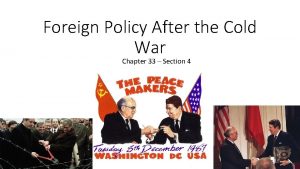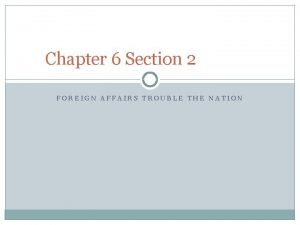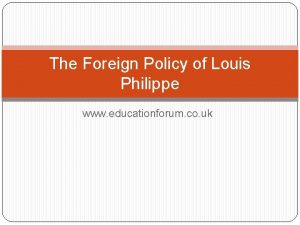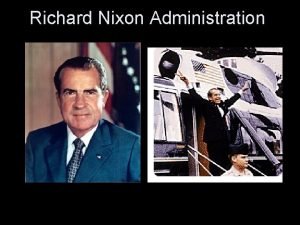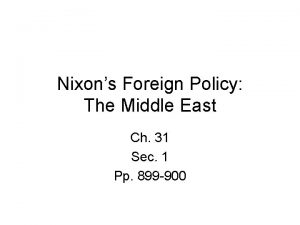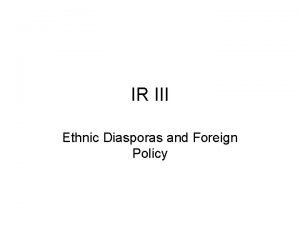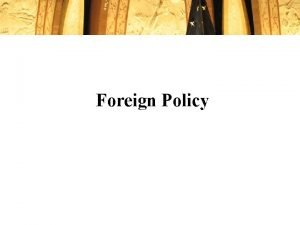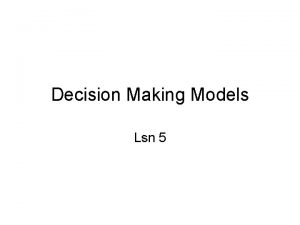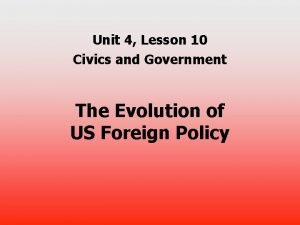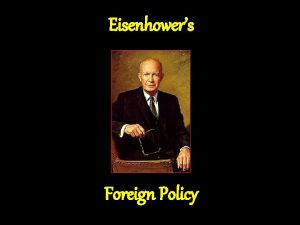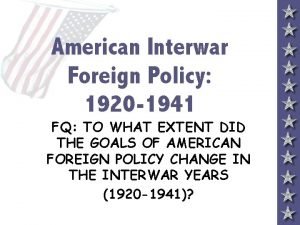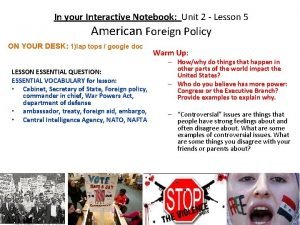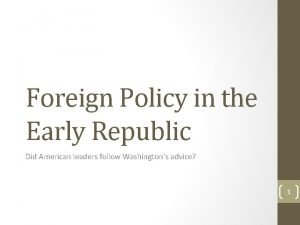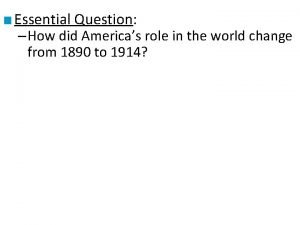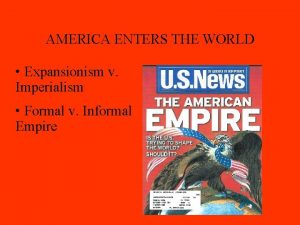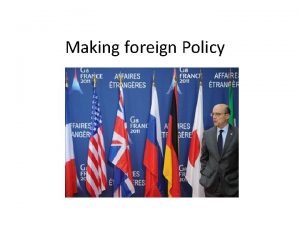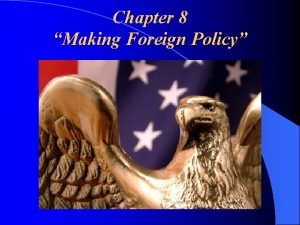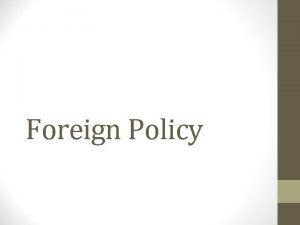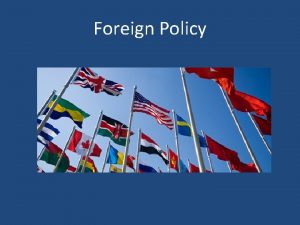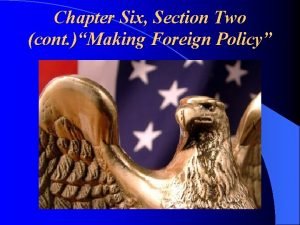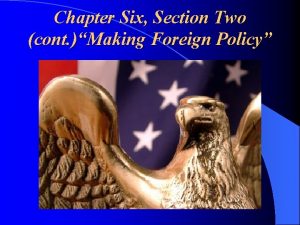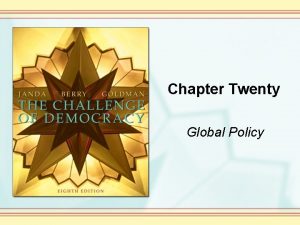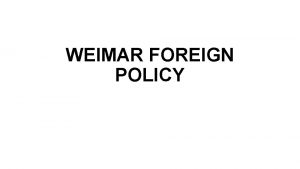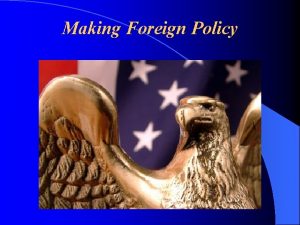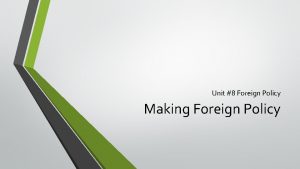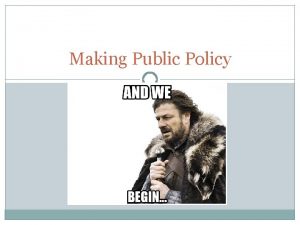Chapter Six Section Three Making Foreign Policy Foreign


















- Slides: 18

Chapter Six, Section Three “Making Foreign Policy”

“Foreign Policy” is the overall plan for dealing with other nations. (whereas, domestic policy is our plan for dealing with the issues/needs within our borders. ) l Foreign Policy essentially deals with four (4) main goals for the United States

1. “National Security” A main goal of foreign policy is to provide “national security”, or the ability to keep the country safe from attack or harm.

2. “International Trade” “International trade” is a key goal of the President’s foreign policy. l It helps create new markets for American goods and provides jobs for American workers.

3. “World Peace” Promoting “world peace” helps keep the United States safe and our vital trade flowing.

4. “Democracy” The desire to promote democracy around the world also helps protect the peace and security of the United States.

Foreign Policy Bureaucracy l Some bureaucracies (federal agencies) that were created to assist the president with foreign policy: – “State Department” – “Defense Department” – “Central Intelligence Agency” (“CIA”) – “National Security Council” (“NSC”)

President & Congress The President and Congress often clash over foreign and military affairs. l The President might want one thing and Congress may want something else…

Foreign Policy Tools “Treaties”, or formal agreements between nations, are vital tools to keep foreign policy. l The “North Atlantic Treaty Organization” (“NATO”) is perhaps our most important treaty (an international alliance that consists of 28 member states from North America and Europe. It was established at the signing of the North Atlantic Treaty on 4 April 1949. Article Five of the treaty states that if an armed attack occurs against one of the member states, it should be considered an attack against all members, and other members shall assist the attacked member, with armed forces if necessary)

Foreign Policy Tools l While the Senate must approve all treaties, the President can issue an “executive agreement” with other leaders in the world.

Foreign Policy Tools “Ambassadors”, or official representatives of a country’s government are very important in foreign policy. l The U. S. currently has over 150 ambassadors in nations it recognizes (or accepts as legitimate) l

Foreign Policy Tools Foreign Aid to nations in need of money, food, supplies, or military assistance is a very important Foreign Policy tool that we use.

Foreign Policy Tools l One famous example of foreign aid came after World War II in Western Europe with the “Marshall Plan” (foreign aid sent to Germany to rebuild after the war. )

Foreign Policy Tools International Trade allows the president to make agreements with other nations concerning trade and trade rules.

Foreign Policy Tools The U. S. can place an “trade sanctions” (or efforts to punish another nation by imposing trade barriers) on nations if necessary.

Foreign Policy Tools We can also set up an “embargo”, or agreement among a group of nations that prohibit them all from trading with a target nation.

Foreign Policy Tools Finally, the president can use military force to carry out some foreign policy decisions.

Foreign Policy Tools l Military Force can be used to protect nations or punish other nations. l This option has been used numerous times over our history.
 Chapter 33 section 4 foreign policy after the cold war
Chapter 33 section 4 foreign policy after the cold war Too foreign for home
Too foreign for home Chapter 6 section 2 foreign affairs trouble the nation
Chapter 6 section 2 foreign affairs trouble the nation 1790 foreign policy
1790 foreign policy Foreign policy of louis philippe
Foreign policy of louis philippe What was thomas jefferson foreign policy
What was thomas jefferson foreign policy Nixons foreign policy
Nixons foreign policy Nixons foreign policy
Nixons foreign policy Actors in foreign policy
Actors in foreign policy Definition of foreign policy by scholars
Definition of foreign policy by scholars Rational actor model cuban missile crisis
Rational actor model cuban missile crisis Unit 4 lesson 10 american foreign policy
Unit 4 lesson 10 american foreign policy Truman foreign policy vs eisenhower
Truman foreign policy vs eisenhower Interwar america
Interwar america Lesson 5 american foreign policy
Lesson 5 american foreign policy Hitler's foreign policy timeline
Hitler's foreign policy timeline Foreign policy in the early republic
Foreign policy in the early republic Foreign policy imperialism
Foreign policy imperialism Foreign policy imperialism
Foreign policy imperialism
